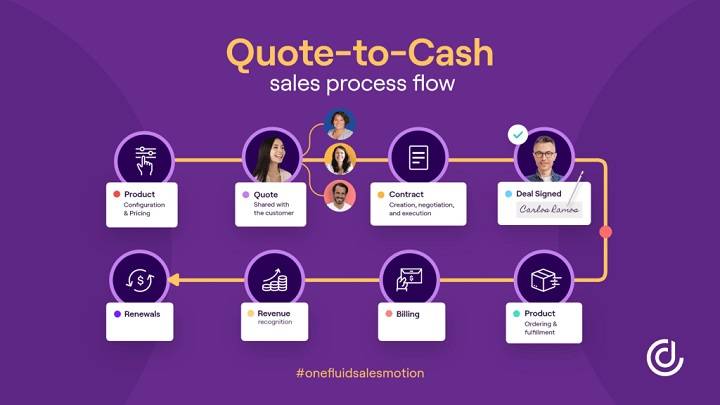
In the fast-paced world of business, optimizing the sales process is crucial for success. One key aspect of this process is the quote to cash process. This article will provide a comprehensive overview of the quote to cash process, exploring its significance, steps involved, and best practices for efficient implementation. So, let’s dive in and explore this vital process that drives revenue generation for organizations.
What is the Quote to Cash Process?
The quote to cash process is a series of interconnected steps that begins with generating a sales quote for a customer and concludes with the collection of payment for the products or services provided. It encompasses various stages, including quoting, order management, billing, and revenue recognition. This end-to-end process ensures seamless coordination between sales, finance, and operations, facilitating a smooth transition from lead to revenue.
The Importance of the Quote to Cash Process
Efficient management of the quote to cash process is vital for businesses to achieve their revenue goals. It enables organizations to:
Accelerate Sales Cycles: By streamlining the process from quoting to invoicing, businesses can reduce delays and friction, ensuring faster conversions and revenue realization.
Improve Customer Experience: A well-executed quote to cash process ensures accurate quotes, timely delivery, and transparent billing, enhancing customer satisfaction and loyalty.
Enhance Operational Efficiency: Automating and integrating the various stages of the process minimizes manual errors, reduces administrative overheads, and boosts overall operational efficiency.
Optimize Revenue Recognition: Proper management of the quote to cash process allows businesses to track revenue recognition, adhere to accounting standards, and ensure accurate financial reporting.
The Quote to Cash Process: Step-by-Step Guide
Implementing the quote to cash process involves several key steps. Let’s explore each stage in detail:
Quote Generation
To initiate the process, a sales representative generates a quote based on the customer’s requirements. This document outlines the products or services offered, pricing, and any applicable terms and conditions.
Quote Review and Approval
Once the quote is prepared, it undergoes an internal review and approval process. This ensures that the quote aligns with the organization’s pricing guidelines and business policies.
Quote Presentation to the Customer
The approved quote is then presented to the customer, either digitally or physically, for their review and acceptance. This step often involves negotiations and revisions to reach a mutually agreed-upon quote.
Order Management
Upon customer acceptance of the quote, the sales team converts the quote into a sales order. This involves recording all relevant details, such as quantities, delivery dates, and customer-specific requirements.
Order Fulfillment
Once the order is received, the fulfillment process begins. This entails sourcing the products or initiating service delivery, coordinating logistics, and ensuring timely fulfillment.
Invoicing and Billing
After successful order fulfillment, the finance team generates an invoice based on the agreed-upon pricing and terms. The invoice is then sent to the customer for payment.
Payment Collection and Reconciliation
Once the customer receives the invoice, they make the payment using the designated payment method. The finance team then reconciles the payment with the corresponding invoice and records it in the financial systems.
Revenue Recognition
The final step involves recognizing the revenue earned from the transaction in compliance with accounting standards and policies. This ensures accurate financial reporting and provides insights into the organization’s financial performance.
Best Practices for Implementing the Quote to Cash Process
To optimize the quote to cash process, organizations can follow these best practices:
Leverage Automation: Utilize sales automation tools, such as configure-price-quote (CPQ) software, to streamline quote generation, reduce errors, and accelerate the sales cycle.
Integrate Systems: Integrate sales, finance, and operations systems to enable seamless data flow, eliminate manual data entry, and enhance overall process efficiency.
Ensure Pricing Consistency: Maintain a centralized pricing repository to ensure consistent and accurate pricing across quotes, orders, and invoices.
Empower Sales Teams: Provide training and resources to sales teams to ensure they have a comprehensive understanding of product offerings, pricing structures, and discount policies.
Implement Approval Workflows: Establish clear approval workflows to ensure quotes adhere to pricing guidelines and business policies before they are presented to customers.
Regularly Review and Optimize: Continuously assess the quote to cash process, identify bottlenecks, and implement improvements to enhance efficiency and customer experience.
FAQs about the Quote to Cash Process
What are the key benefits of implementing a quote to cash process?
Implementing a quote to cash process offers benefits such as accelerated sales cycles, improved customer experience, enhanced operational efficiency, and optimized revenue recognition.
How can automation help streamline the quote to cash process?
Automation tools like configure-price-quote (CPQ) software can automate quote generation, reduce errors, and accelerate the sales cycle, resulting in increased efficiency and productivity.
What role does integration play in the quote to cash process?
Integration of sales, finance, and operations systems enables seamless data flow, eliminates manual data entry, and ensures real-time visibility into the sales pipeline, order status, and revenue.
How can organizations maintain pricing consistency across quotes, orders, and invoices?
Maintaining a centralized pricing repository ensures consistent and accurate pricing across the entire quote to cash process, minimizing errors and confusion.
What are some common challenges faced during the quote to cash process?
Common challenges include inaccurate quotes, inefficient approval processes, disjointed systems, manual data entry errors, and inadequate visibility into the sales pipeline and revenue recognition.
How can organizations continuously improve the quote to cash process?
Regularly reviewing the process, identifying bottlenecks, and implementing improvements based on feedback and data analysis are essential for continuous optimization of the quote to cash process.
The quote to cash process serves as the backbone of efficient sales and revenue generation. By effectively managing each stage, from quote generation to cash collection, organizations can accelerate sales cycles, enhance customer experience, and optimize revenue recognition. Implementing best practices, leveraging automation, and maintaining pricing consistency are key to streamlining this critical business process. So, embrace the quote to cash process and unlock its potential to drive success in your organization.



